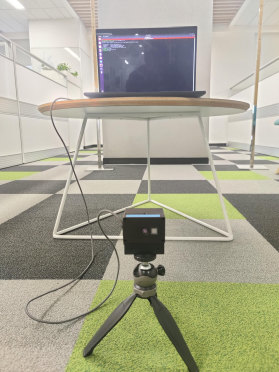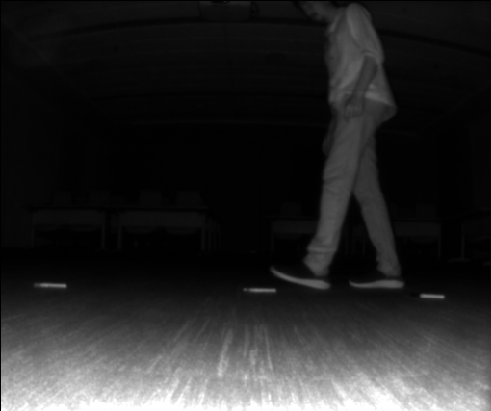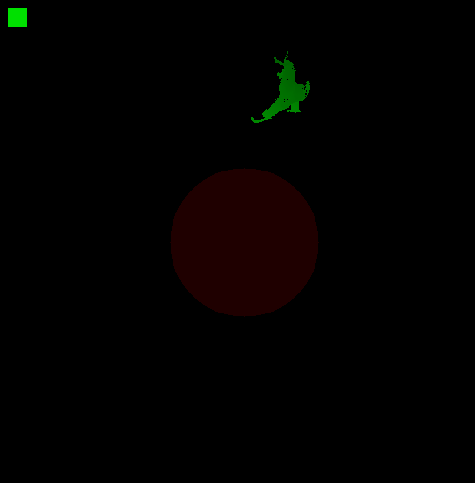The ADI 3DToF Safety Bubble Detector is a ROS (Robot Operating System) package for the Safety Bubble Detection application. The Safety Bubble Detectors are the basic building block of any AGV/AMR. The safety zone is a virtual area around an AGV/AMR. The Safety Bubble Detectors are used to detect the presence of any object inside this zone and prevent the AGV/AMR from colliding on to the object.
The ADI 3DToF Safety Bubble Detector is developed as a ROS application running on the ADI’s EVAL-ADTF3175D-NXZ Time-of-Flight platform. The Safety Bubble Detection algorithm is highly optimized to run at 30FPS on the EVAL-ADTF3175D-NXZ platform. The node uses ADI ToF SDK APIs to capture the frames from the sensor. The algorithm is run on the captured images and the output is published as ROS topics. The Node publishes the detection flag and the output visualization image as the topics. The Depth and IR images are also published as ROS topics. The topics are published at 30FPS. The default topic names are listed below.
- EVAL-ADTF3175D-NXZ Module
- USB Type-C to Type-A cable - with 5gbps data speed support
- Host laptop with intel i5 or higher cpu running Ubuntu-20.04LTS
📝 Note: Refer the EVAL-ADTF3175D-NXZ User Guide to ensure the Eval module has adequate power supply during operation.
The image below shows the connection diagram of the setup:
📝 ADSD3500 Firmware :
Make sure the sensor is flashed with the compatible FW. The minimum version is listed below:
CR/DV series : 4.1.0.0
AM series : 4.2.0.0
Follow the below instructions to read the FW version
- Login to the EVAL-ADTF3175D-NXZ module using ssh. On the Host machine open the “Terminal” and run the following command to ssh to the device.
$ ssh analog@10.42.0.1 Username: analog Password: analog- Run the follwing commands
$ cd ~/Workspace/Tools/ctrl_app $ ./ctrl_appThe output would look like below,
V4L2 custom control interface app version: 1.0.1
59 31
04 02 01 00 61 35 39 61 66 61 64 36 64 36 63 38 65 37 66 62 31 35 33 61 32 64 62 38 63 64 38 38 34 30 33 35 39 66 31 37 31 39 35 61
59 31
The first four bytes in the third line represents the FW version. For example for the output above, the version is 4.2.1.0
If the firware version is older than this please upgrade the FW using the following instructions
- Install ADI ToF SDK release v4.2.0
- After installing goto the inastallation folder and run the following commands to download the image
$ cd ~/Analog\ Devices/ToF_Evaluation_Ubuntu_ADTF3175D-Relx.x.x/image. $ chmod +x get_image.sh and ./get_image.sh.
Latest image will be downloaded at ./image path as NXP-Img-Relx.x.x-ADTF3175D-.zip. Extract this folder using unzip NXP-Img-Relx.x.x-ADTF3175D-.zip command.
This folder contains the NXP image and ADSD3500 firmware(Fw_Update_x.x.x.bin).
- Run the following command to copy the Fimware to the NXP device
$ scp Fw_Update_4.2.4.bin analog@10.42.0.1:/home/analog/Workspace Username: analog Password: analog
- Now login to the device and run the Firmware upgrade command.
⚠️ Do not interrupt/abort while the upgrade is in progress.Doing this may corrupt the module.$ ssh analog@10.42.0.1 Username: analog Password: analog $ cd Workspace/ToF/build/examples/data_collect/ $ ./data_collect --fw ~/Workspace/Fw_Update_x.x.x.bin config/config_default.json
- Reboot the board after the successful operation.
For details refer to EVAL-ADTF3175D-NXZ NVM upgrade guide
Assumptions before building this package:
- Linux System or WSL2(Only Simulation Mode supported) running Ubuntu 20.04LTS
- To install WSL2 and ROS follow these steps
- ROS Noetic: If not installed, follow these steps.
- Setup catkin workspace (with workspace folder named as "catkin_ws"). If not done, follow these steps.
-
Download and install the latest version of ADI 3DToF Safety Bubble Detector from the Release pages.
-
After installing the software, go to the installation folder(~/Analog Devices/ADI3DToFSafetyBubbleDetector/image) and run the get_image.sh script. This script will download the custom Ubuntu 20.04 image for the EVAL-ADTF3175D-NXZ.
-
Flash .img file to the SD card, follow steps in this link EVAL-ADTF3175D-NXZ Users Guide to flash the .img file to SD card.
Note: This image contains the necessary software and code to start using the ROS node. The source code for the
adi_3dtof_safety_bubble_detectorcan be found in/home/analog/catkin_ws/src/ -
Follow the instructions below to run the adi_3dtof_safety_bubble_detector application on the EVAL-ADTF3175D-NXZ module.
-
Connect the EVAL-ADTF3175D-NXZ module to the PC using the USB3.0 cable and wait for the network to come up. By default, the device ip is set to 10.42.0.1. Refer to EVAL-ADTF3175D-NXZ Startup Guide for details.
-
Login to the EVAL-ADTF3175D-NXZ module using ssh. On the Host machine open the “Terminal” and run the following command to ssh to the device.
$ ssh analog@10.42.0.1 Username: analog Password: analog
Note: If you do not have a Linux Host machine, then install Windows Subsystem for Linux(WSL) and Ubuntu 20.04 on Windows. Refer to this link for instructions.
📝
- Setting Date/Time:
Make sure the Date/Time is set properly before compiling and running the application. Connecting to a WiFi network would make sure the Date/Time is set properly. The custom Ubuntu 20.04 image is configured to connect to a network with following SSID and Password by default.
SSID : ADI, Password: analog123
You can either setup a network with the above properties or configure the Device to connect to any available network.
Alternatively, the Host machine can be setup as a local NTP server and the devices can be configured to update Date/Time using the Host machine.
Refer to below links for setting and configuring NTP on Ubuntu machines.
- The ROS Noetic and dependent packages are already installed in the EVAL-ADTF3175D-NXZ image and the source code for the adi_3dtof_safety_bubble_detector is present in
/home/analog/catkin_ws/src/folder. The package is also pre-built, hence there is no need to build the package.
If the source files are modified, then use the following commands to build the package.$ cd ~/catkin_ws/ $ catkin_make -DCMAKE_BUILD_TYPE=RELEASE -j2Note:
/home/analog/catkin_ws/is set up as the catkin workspace and this workspace is already sourced in the~/.bashrc
-
Running the ROS Node:
On the EVAL-ADTF3175D-NXZ device, the ROS Master is set to the IP address of the Host machine, hence it is required to run
roscoreon the Host machine (applicable only to Linux host).On the Linux Host, open a terminal and run the following command
$ roscore
On the Device:
$ roslaunch adi_3dtof_safety_bubble_detector adi_3dtof_safety_bubble_detector_single_camera.launch
📝Note:
If you are using WSL as the Host machine, then setting Host as ROS Master does not work. In this case, you must unset the ROS master on device. Run the following command to unset the ROS Master and use the EVAL-ADTF3175D-NXZ as the ROS master. On the WSL Host, open an Ubuntu 20.04 Terminal and run the following command$ export ROS_MASTER_URI=http://10.42.0.1:11311 $ export ROS_IP=10.42.0.100
On Device,
$ unset ROS_MASTER_URI $ roslaunch adi_3dtof_safety_bubble_detector adi_3dtof_safety_bubble_detector_single_camera.launchAt this stage, the adi_3dtof_safety_bubble_detector will be launched and start publishing the topics
/cam1/depth_image, /cam1/ir_image, /cam1/out_image, /cam1/obect_detected and /cam1/camera_info.To see the depth and IR images on the Host machine, simply open the RVIZ and add
/cam1/depth_image,/cam1/ir_imageand/cam1/out_imagetopics to visualize the images -
Publishing compressed output image
This feature enables multiple sensors to run in 30FPS.
change the below parameter in
adi_3dtof_safety_bubble_detector_single_camera.launchfile.arg_enable_output_image_compression set it to 1
On the Device:
$ roslaunch adi_3dtof_safety_bubble_detector adi_3dtof_safety_bubble_detector_single_camera.launch
On host:
$ roslaunch adi_3dtof_safety_bubble_detector adi_3dtof_safety_bubble_detector_single_camera_host.launch
Note: The camera prefix with device is publishing output image should match with
ns_prefix_camargument present inadi_3dtof_safety_bubble_detector_single_camera_hostlaunch file.
Sample output images are shown below:
/cam1/depth_image
/cam1/ir_image
/cam1/out_image
To setup Safety Bubble Detector with 4 devices refer Setting up 4 device for Safety Bubble Detector
These are the default topic names, topic names can be modified as a ROS parameter.
-
/depth_image
- 16-bit Depth image of size 512X512
-
/ir_image
- 16-bit IR image of size 512X512
-
/out_image
- 8-bit output image of size 512X512
-
/object_detected
- boolean to indicate the object detection
-
/camera_info
- Camera info
If RVL image-compression is enabled:
- /depth_image/compressedDepth
- 512X512 16-bit Depth image from adi_3dtof_safety_bubble_detector node compressed with RVL compression
- /ir_image/compressedDepth
- 512X512 16-bit IR image from adi_3dtof_safety_bubble_detector node compressed with RVL compression
- /out_image/compressed
- 512X512 8-bit output image from adi_3dtof_safety_bubble_detector node compressed with RVL compression
-
param_camera_link (String, default: "adi_camera_link")
- Name of camera Link
-
param_optical_camera_link (String, default: "optical_camera_link")
- Name of optical camera Link
-
param_virtual_camera_link (String, default: "virtual_camera_link")
- Name of virtual camera Link
-
param_safety_zone_radius_in_mtr (float, default: 1.0f)
- Safety zone radius
-
param_safety_bubble_shape (int, default: 0)
- Safety bubble shape, 0:circular, 1:Square
-
param_virtual_camera_height (float, default: 5.0f)
- Virtual camera height, default value is 5 meters.
-
param_input_sensor_mode (int, default: 0)
- Input mode, 0:Real Time Sensor, 2:Rosbag bin
-
param_output_sensor_mode (int, default: 0)
- Output mode, 0:No output files written, 1:avi and csv output files are written
-
param_input_file_name_or_ros_topic_prefix_name (String, default: "no name")
- Input filename : Applicable only if the input mode is 2 or 3
- If input mode is 2 this parameter represents input file name
- If input mode is 3 this parameter represents the prefix of ros topics.
-
param_enable_ransac_floor_detection (int, default: 1)
- enable option for ransac floor detection, 0: disable, 1:enable
-
param_enable_depth_ir_compression (int, default: 0)
- enable option to publish depth and ir compressed images, 0: disable, 1:enable
-
param_enable_output_image_compression (int, default: 0)
- enable option to publish compressed output image, 0: disable, 1:enable
-
param_safety_bubble_sensitivity (int, default: 10)
- number of connected pixels to trigger object detection
-
param_enable_floor_paint (int, default: 0)
- enable option to visualize for floor paint, 0: disable, 1:enable
-
param_enable_safety_bubble_zone_visualization (int, default: 0)
- enable option to visualize safety bubble zone, 0: disable, 1:enable
-
param_input_image_width (int, default: 1024)
- image width
-
param_input_image_height (int, default: 1024)
- image height
-
param_processing_scale (int, default: 0)
- scale factor to determine some algorithm parameters
-
param_ransac_distance_threshold_mtr (float, default: 0.025f)
- the height of the floor ransac can find, default value is 2.5 cms
-
param_ransac_max_iterations (int, default: 10)
- maxium iterations ransac is allowed
-
param_ab_threshold (int, default: 10)
- abThreshold for the sensor
-
param_confidence_threshold (int, default: 10)
- confidenceThreshold for the sensor.
- For Sensor serial number CR and DV default value is 10, for Sensor serial number AM default value is 25.
-
param_enable_depth_ir_compression (int, default: 0)
- Enables RVL compression for the depth images
-
param_config_file_name_of_tof_sdk (String, default: "config/config_crosby_old_modes.json")
- Configuration fie name of ToF SDK
"config_crosby_old_modes.json" - For CR/DV series of Eval Boards
"config_crosby_adsd3500_new_modes.json" - For AM series of Eval Boards
- Configuration fie name of ToF SDK
-
param_frame_type (String, default: "qmp")
- Frame Type
"qmp" - For CR/DV series of Eval Boards
"lr-qnative" - For AM series of Eval Boards
- Frame Type
-
/combo_safety_bubble_out_image
- 8-bit output image of size 512X512
-
/combo_safety_bubble_object_detected
- boolean topic indicates object detection
-
/object_detected
- boolean topic indictes object detection
-
/out_image/compressed
- subscribes output image from adi_3dtof_safety_bubble_detector node
- camera_prefix (String, default: "no name")
- ROS Topic prefix name to subscribe
📝 Notes:
- If any of these parameters are not set/declared, default values will be used.
- Enabling file input may slow down the speed of publishing.
Using Dynamic Reconfigure some parameters of adi_3dtof_safety_bubble_detector ROS node can be modifed during run time. The Perspective file is present in rqt_config/ folder.
roslaunch adi_3dtof_safety_bubble_detector adi_3dtof_safety_bubble_detector_rqt.launch
Make sure the adi_3dtof_safety_bubble_detector is already running before executing this command.
None
Please contact the Maintainers if you want to evaluate the algorithm for your own setup/configuration.
Any other inquiries are also welcome.
The Node can be run on a Host machine without the need for the actual 3DToF sensor. This mode is supported for users who would want to test some algorithms on the recorded video files. In this mode the adi_3dtof_safety_bubble_detector_node will read the video file and publish the frames as ROS topics. Follow the below instructions to build and run the node in File-IO mode.
Note: It is assumed that the correct version of ROS is installed and configured properly, if not please install the ROS from here
To run the adi_3dtof_safety_bubble_detector_node in file-io mode, the video files should be given as input. Please follow the below instructions to set up the input video files.
- Go to the installation directory of the ADI 3DToF ADTF31xx appliation (~/Analog Devices/ADI3DToFADTF31xx-Rel1.0.0/videos)
- Run the get_videos.sh script which will download the adi_3dtof_input_video_files.zip file in the current directory.
- Unzip it and copy the directory as ~/catkin_ws/src/adi_3dtof_input_video_files.
- Update the input file argument arg_input_file_name_or_ros_topic_prefix_name in the launch file adi_3dtof_safety_bubble_detector_single_camera.launch as per the above file path.
-
Clone the repo and checkout the corect release branch/ tag into catkin workspace directory
$ cd ~/catkin_ws/src $ git clone https://github.com/analogdevicesinc/adi_3dtof_safety_bubble_detector.git -b v1.0.0
-
Install dependencies:
$ cd ~/catkin_ws/ $ rosdep install --from-paths src -y --ignore-src
-
Build the package
$ cd ~/catkin_ws/src $ catkin_make -DCMAKE_BUILD_TYPE=RELEASE -DHOST_BUILD=TRUE -j2 $ source devel/setup.bash
-
To run the adi_3dtof_safety_bubble_detector_node in File-IO mode, we need to make some changes in the launch file. Change the following parameters in launch file.
arg_input_sensor_mode to be set to 2
arg_input_file_name_or_ros_topic_prefix_name to be set to the input file name
-
After updating the launch file, run the roslaunch with the updated launch file.
$ roslaunch adi_3dtof_safety_bubble_detector adi_3dtof_safety_bubble_detector_single_camera.launch
At this stage, the adi_3dtof_safety_bubble_detector_node will be launched and start publishing the topics /cam1/depth_image, /cam1/ir_image, /cam1/out_image, /cam1/camera_info and /cam1/object_detected.
To see the depth and IR images open an other Terminal and open the RVIZ and add /cam1/depth_image, /cam1/ir_image and /cam1/out_image topics to visualize the images
For details on the parameters please refer to the launch files present in the launch/ folder.











